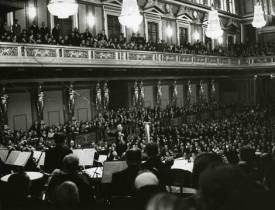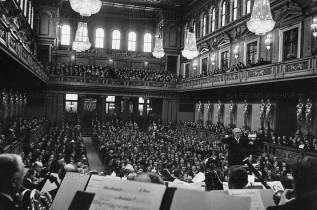
Clemens Heinrich Krauss (March 31, 1893 – May 16, 1954) Clemens Heinrich Krauss was an Austrian conductor and opera impresario, particularly associated with the music of Richard Strauss. Krauss was born in Vienna, the out-of-wedlock child of Clementine Krauss, then a 15-year-old dancer in the Vienna Imperial Opera Ballet, later a leading actress and operetta singer, who was a niece of the prominent nineteenth-century operatic soprano, Gabrielle Krauss (1842-1904). His natural father, the chevalier Hector Baltazzi (1851-1916), belonged to a family of wealthy Phanariot bankers resident in Vienna. Baltazzi's older sister Helene was married to Baron Albin Vetsera and was the mother of Baroness Mary Vetsera, who was thus Clemens Krauss' first cousin. As a boy, Krauss was a chorister in the Hofkapelle (Imperial Choir). He attended the Vienna Conservatory, graduating in 1912. He studied composition with Hermann Graedener and theory with Richard Heuberger. After graduation he was chorus master in the Brno Theater (1912-1913). There he made his conducting debut in 1913. The famous Romanian soprano Viorica Ursuleac, with whom he often performed, was his second wife. Krauss made the rounds of regional centers, conducting in Riga (1913-1914), Nuremberg (1915), and Stettin (1916-1921), now known as Szczecin. The latter appointment gave him ample opportunity to travel to Berlin to hear Arthur Nikisch conduct the Berlin Philharmonic, a major influence. Krauss's next post was back in Austria, where he became director of the opera and symphony concerts in Graz. In 1922 he joined the conducting staff of the Vienna State Opera and teacher of the conducting class at the State Academy of Germany. In 1923 he became conductor of the Vienna Tonkünstler Concerts until 1927, and Intendant of the opera in Frankfurt am Main and director of the Museum Concerts in 1924, until 1929. Krauss visited the United States in 1929, conducting in Philadelphia and with the New York Philharmonic. Also in 1929 he became director of the Vienna State Opera. Its orchestra, in its independent concert form as the Vienna Philharmonic, appointed him its music director in 1930. He was a regular conductor at the Salzburg Festival from 1926 to 1934. In 1930 he conducted Alban Berg's Wozzeck. In 1933 and 1934 Krauss gave up his Vienna positions, becoming director of the Berlin State Opera in 1935 after Erich Kleiber resigned in protest over Nazi rule. In 1933 he took over the preparations for the premieres of Strauss's Arabella when the conductor Fritz Busch (another non-Jewish anti-Nazi) left. Krauss's own position on Nazism was unclear, although he enjoyed a close relationship with Nazi official Alfred Frauenfeld and it has been claimed that he sought Nazi Party membership in 1933. In 1937 he was appointed Intendant of the National Theatre Munich, following the resignation there of Hans Knappertsbusch. He became a close friend of Richard Strauss, for whom he wrote the libretto to the opera Capriccio which he premiered in Munich in 1942. Also, he conducted the premieres of Strauss's operas Friedenstag and Die Liebe der Danae. During the early 1940s he taught at the Mozarteum University of Salzburg where among his pupils was composer Roman Toi. After the Munich opera house was bombed, shutting it down, Krauss returned to conduct the Vienna Philharmonic until it closed shortly before the end of the War (1944-45). After the War, Allied officials investigated his pro-Nazi activities and because of them forbade him from appearing in public until 1947. They also found that he had frequently acted to assist a number of individual Jews escape the Third Reich machine. When his ban was lifted he resumed frequently conducting the Vienna Philharmonic, including its famous New Year's Day concerts.

The New Year Concert of the Vienna Philharmonic (in German: Das Neujahrskonzert der Wiener Philharmoniker) is a concert of classical music that takes place each year in the morning of January 1 in Vienna, Austria. It is broadcast around the world to an estimated audience of 50 million in 72 countries (as of 2010). The music always includes pieces from the Strauss family – Johann Strauss I, Johann Strauss II, Josef Strauss and Eduard Strauss – with occasional additional music from other mostly Austrian composers, including Joseph Hellmesberger, Jr., Joseph Lanner, Wolfgang Amadeus Mozart, Otto Nicolai (the Vienna Philharmonic's founder), Emil von Reznicek, Franz Schubert, Franz von Suppé, and Karl Michael Ziehrer. In 2009 music by Joseph Haydn was played for the first time: the 4th movement of his "Farewell" Symphony to mark the 200th anniversary of his death. There are traditionally about a dozen compositions played, with a pause at the half and encores at the end. They include waltzes, polkas, mazurkas, and marches. Of the encores, the first is often a fast polka. The second is Johann Strauss II's waltz The Blue Danube, whose introduction is interrupted by applause of recognition and a New Year greeting from the musicians to the audience. The last is Johann Strauss I's Radetzky March, during which the audience claps along under the conductor's wry direction. The complete duration of the event is around two and a half hours. The concerts have been held in the "Großer Saal" (Large Hall) of the Musikverein since 1939. The orchestra is joined by pairs of ballet dancers in selected pieces during the second part of the programme. The dancers come from the Vienna State Opera Ballet and dance at different famous places in Austria, as Schönbrunn Palace, Schloss Esterházy, the Vienna State Opera or the Wiener Musikverein itself. Since 1980 the flowers that decorate the hall have been a gift from the city of Sanremo, Liguria, Italy. The concert was first performed in 1939, and conducted by Clemens Krauss. For the first and only time, the concert was not given on New Year's Day, but instead on December 31 of that year. It was called then a special, or extraordinary concert (Außerordentliches Konzert). Johann Strauss II was the only composer performed. There were no encores in 1939, and sources indicate they did not begin until 1945. Clemens Krauss almost always included "Perpetuum mobile" either on the concert or as an encore. Surprisingly, the waltz The Blue Danube was not performed until 1945, and then as an encore. The Radetzky March was first performed in 1946, as an encore. Until 1958 these last two pieces were often but not always given as encores. Since that year their position as twin encores has been inviolable tradition, with two exceptions: in 1967 Willi Boskovsky made the Blue Danube part of his concert program and in 2005 Lorin Maazel concluded the program with the Blue Danube, omitting the Radetzky March as a mark of respect to the victims of the 2004 Indian Ocean earthquake and tsunami. Boskovsky, concertmaster of the orchestra 1936–1979, conducted the Vienna New Year's concerts from 1955–1979. In 1980, Lorin Maazel became the first non-Austrian conductor of the concert. The practice of choosing a different star conductor every year (and occasional star soloists) began in 1987 after seven appearances in a row by Maazel. Members of the orchestra voted to rotate conductors. This may have occurred with the telecasts going worldwide, perhaps to make the audio and video recordings more marketable. The first of these rotating stars was Herbert von Karajan, an Austrian, then 78 and in frail health.
Clemens Krauss, 1939, 1941–1945, 1948–1954
Josef Krips, 1946–1947
Willi Boskovsky, 1955–1979
Lorin Maazel, 1980–1986, 1994, 1996, 1999, 2005
Herbert von Karajan, 1987
Claudio Abbado, 1988, 1991
Carlos Kleiber, 1989, 1992
Zubin Mehta, 1990, 1995, 1998, 2007
Riccardo Muti, 1993, 1997, 2000, 2004
Nikolaus Harnoncourt, 2001, 2003
Seiji Ozawa, 2002
Mariss Jansons, 2006, 2012
Georges Prêtre, 2008, 2010
Daniel Barenboim, 2009
Franz Welser-Möst, 2011
Photos from New Year's Concert 1954

Josef Strauss Schwert und Leider; Waltz - Josef Strauss Rudolfsheimer-Polka; op. 152 - Josef Strauss Die Libelle; Polka Mazur; op. 204 - Josef Strauss Auf Ferienreisen; Polka; op. 133 Josef Strauss Auf Ferienreisen; Polka; op. 133 (Encore) - Johann Strauss II Bei uns z’haus; Walzer; op. 361 - Johann Strauss II Neue-Pizzicato-Polka; op. 449 Johann Strauss II Neue-Pizzicato-Polka; op. 449 (Encore) - Johann Strauss II Eljen a Magyar!; Polka schnell; op. 332 Johann Strauss II Eljen a Magyar!; Polka schnell; op. 332 (Encore) - Josef Strauss Spharenklange; Walzer; op. 235 -
Josef Strauss Mailusts; Polka schnell; op. 182 -
Josef Strauss Plappermaulchen; Polka schnell; op. 245 Josef Strauss Plappermaulchen; Polka schnell; op. 245 (Encore) -
Johann Strauss II Im Krapfenwald’l; Polka francaise; op. 336 -
Johann Strauss II Fruhlingsstimmen; Walzer; op. 410 (interrupted by applause) Johann Strauss II Fruhlingsstimmen; Walzer; op. 410 -
Johann Strauss II Auf der Jagd; Polka schnell; op. 373 Johann Strauss II Auf der Jagd; Polka schnell; op. 373 (Encore) -
Johann Strauss II Perpetuum mobile; Polka; op. 257 -
Johann Strauss II An der schonen blauen Donau; Walzer; op. 314 -
Johann Strauss I Radetzky-Marsch; op. 228 (interrupted by applause) Johann Strauss I Radetzky-Marsch; op. 228
*****
Clemens Krauss
1.01.1954
*****
Материал взят из интернета довольно давно с какого-то японского или китайского сайта, сейчас, к сожалению, уже точно не помню. Если кто-то узнает и напомнит, буду благодарен.
| 
